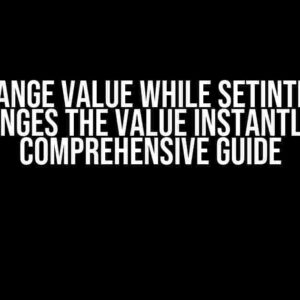Are you tired of encountering the dreaded ReferenceError when trying to call a function in an Angular HTML element using the onclick attribute? Well, buckle up, dear developer, because today we’re going to tackle this pesky issue head-on and emerge victorious!
The Problem: A ReferenceError in the Console
You’ve probably tried something like this:
<button onclick="myFunction()">Click me!</button>And, much to your chagrin, the console spits out a ReferenceError, complaining that it can’t find your function. But, wait! You’re certain that you’ve defined the function in your component. So, what’s going on?
The Reason: Angular’s Change Detection Mechanism
Angular’s change detection mechanism is the culprit behind this issue. When Angular compiled your HTML, it didn’t bother to register your function in the global scope. Instead, it created a closure around your component, making it inaccessible from the HTML.
Now, you might be thinking, “But hey, I’ve used console.log to log my function, and it works just fine!” And you’re right! Console.log can access the function because it’s executed in the context of the component. However, when you try to call the function from the HTML using onclick, it’s executed in the global scope, where the function is not available.
The Solution: Using Angular’s Event Binding
So, how do you call a function from an Angular HTML element? The answer lies in using Angular’s event binding syntax. Instead of using the onclick attribute, you’ll need to use the (click) event binding.
<button (click)="myFunction()">Click me!</button>By using (click), you’re telling Angular to listen for the click event and execute the myFunction() method when it occurs. This way, the function is called in the context of the component, avoiding the ReferenceError.
Example: A Simple Toggle Button
Let’s create a simple toggle button that toggles a boolean value when clicked.
<button (click)="toggleBoolean()">Toggle boolean value</button>
<p>Boolean value: {{ booleanValue }}</p>
In your component, define the toggleBoolean() method:
export class MyComponent {
booleanValue = false;
toggleBoolean() {
this.booleanValue = !this.booleanValue;
}
}
Now, when you click the button, the booleanValue will toggle correctly!
Common Scenarios and Solutions
Let’s explore some common scenarios where you might encounter the ReferenceError and their solutions:
Scenario 1: Calling a Function with Parameters
Sometimes, you need to pass parameters to your function. In this case, you can use template literals to concatenate the parameter values.
<button (click)="myFunction('Hello, ' + name)">Click me!</button>Alternatively, you can use a lambda function to wrap your function call:
<button (click)="(() => myFunction('Hello, ' + name))()">Click me!</button>Scenario 2: Calling a Function from a Child Component
When you need to call a function from a child component, you can use the @Output decorator to emit an event.
// Child component
<button (click)="emitEvent()">Click me!</button>
export class ChildComponent {
@Output() myEvent = new EventEmitter<>();
emitEvent() {
this.myEvent.emit();
}
}
// Parent component
<child-component (myEvent)="myFunction()"></child-component>
In the parent component, you can then call your function when the event is emitted.
Best Practices and Conclusion
When working with Angular, it’s essential to understand the difference between the global scope and the component scope. By using Angular’s event binding syntax and following best practices, you can avoid the ReferenceError and create robust, maintainable applications.
Remember:
- Use (click) or other event binding syntax instead of onclick.
- Avoid using global functions; instead, define them in your component.
- Use template literals or lambda functions to pass parameters to your functions.
- Communicate between components using the @Output decorator and event emission.
By following these guidelines, you’ll be well on your way to becoming an Angular master and conquering the ReferenceError once and for all!
| Scenario | Solution |
|---|---|
| Calling a function with parameters | Use template literals or lambda functions |
| Calling a function from a child component | Use the @Output decorator and event emission |
Now, go forth and Angular-ify your HTML with confidence!
Here is the FAQ in the requested format:
Frequently Asked Question
Get the answers to the most frequently asked questions about Angular HTML calling a function in onclick giving ReferenceError but console.log working.
Why am I getting a ReferenceError when calling a function in onclick in Angular HTML?
This error occurs when the function you’re trying to call is not within the scope of the component’s template. Make sure the function is defined in the component’s class and is public. Also, ensure that you’re using the correct syntax for calling the function in the HTML template.
Why does console.log work but calling a function in onclick doesn’t?
Console.log works because it’s a global function, whereas the function you’re trying to call is specific to your component’s class. The onclick event is triggered outside the component’s scope, which is why it can’t find the function. To fix this, you need to ensure that the function is properly bound to the component’s scope.
How do I bind a function to the component’s scope in Angular?
You can bind a function to the component’s scope by using an arrow function or by binding the function to the component’s `this` context. For example, you can use `(onclick)=”myFunction.bind(this)()”` or `(onclick)=”() => myFunction()”` to ensure that the function is called within the component’s scope.
What is the difference between a function and a method in Angular?
A function is a standalone block of code that can be called independently, whereas a method is a function that is part of a class. In Angular, methods are bound to the component’s class and can access the component’s properties and other methods. Functions, on the other hand, are not bound to the component’s class and can’t access its properties or methods.
How can I debug ReferenceError issues in Angular?
To debug ReferenceError issues in Angular, you can use the browser’s developer tools to check the console output for error messages. You can also use Angular’s built-in debugging tools, such as the Augury Chrome extension, to inspect the component’s scope and debug the issue.



